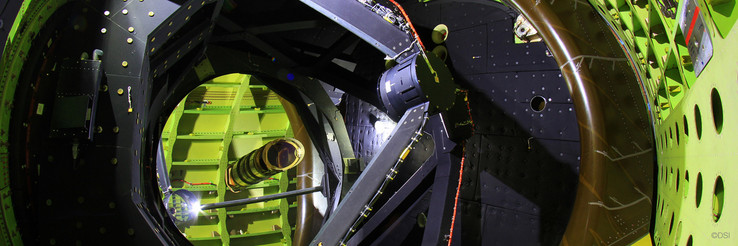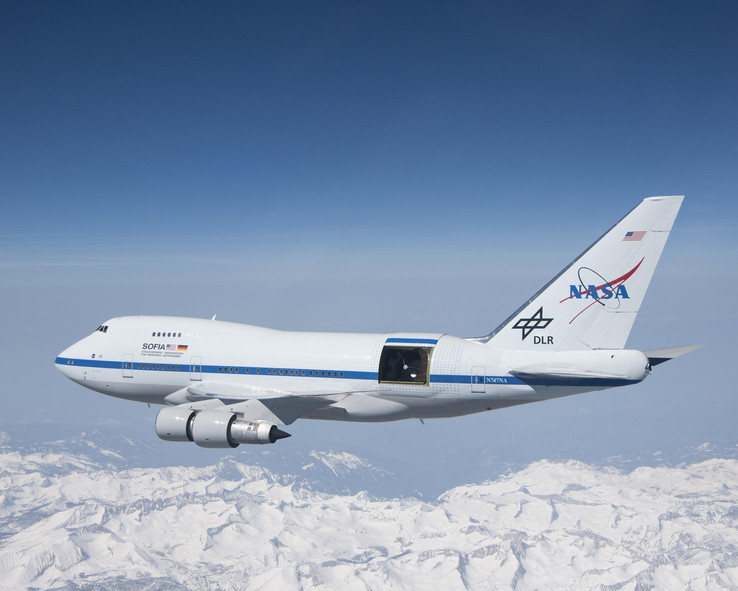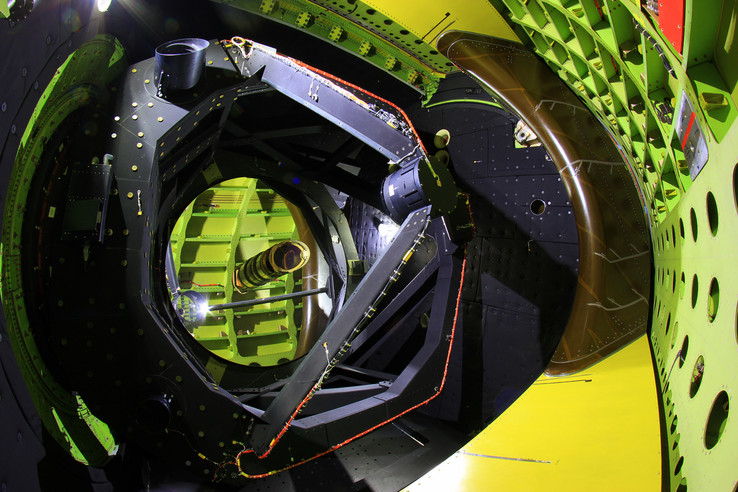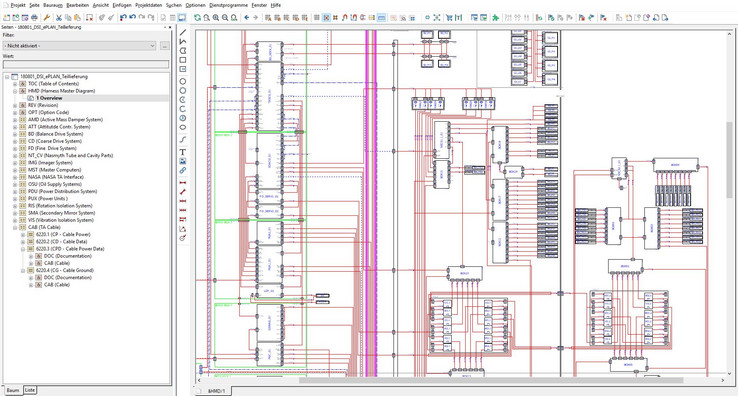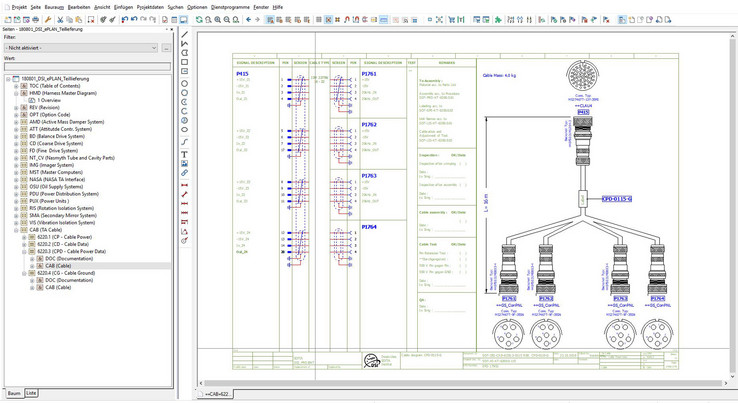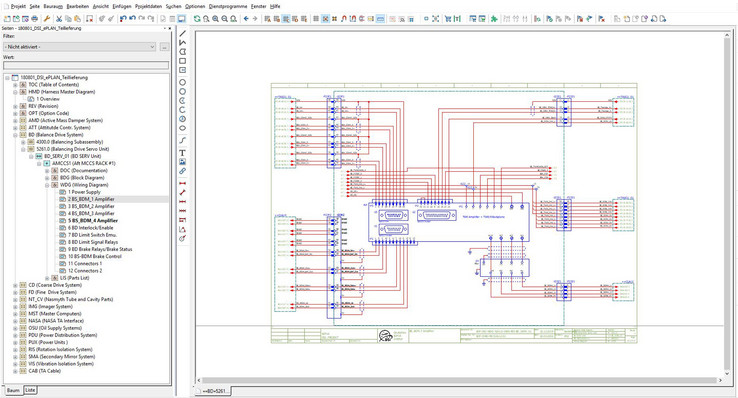독보적인 "비행 관측 장치"에 사용되는 EPLAN 문서
파일 선반에서 표준화된 데이터로
SOFIA의 연구용 항공기는 8년째 운영 중이며, 적외선을 기록하여 우주를 면밀히 관찰할 수 있도록 합니다. 이 독보적인 망원경의 복잡한 전기 엔지니어링은 오랫동안 종이와 PDF 문서 형태로만 가용했습니다. University of Stuttgart 산하 독일 SOFIA 연구소(DSI)의 엔지니어와 테크니션 인력은 이제 기초 천문학 연구의 특별 요건에 맞게 정밀 조정된 EPLAN 솔루션을 사용하고 있습니다.
위에서 내려다보는 뷰가 항상 더 나은 법입니다. 이 원칙은 천문학에도 적용되는데요. 만약 사람들이 적외선 스펙트럼을 사용하여 우주를 관측하고자 한다면, 지구상에서는 얻을 게 별로 없을 것입니다. 적외선은 지구 대기의 수증기를 통과할 수 없기 때문입니다.
이러한 이유로 NASA와 DLR(독일 항공우주 센터)도 2010년 세계 유일의 ‘비행 관측 장치’를 가동하기로 결정한 것입니다. 보잉 747SP에 17톤에 달하는 망원경과 2.7m 직경의 거울을 장착한 비행 관측 장치는 13~14km의 고도에서 항성의 형성과 행성 시스템 등에 대한 심층적 통찰을 제공합니다.
SOFIA(Stratospheric Observatory for Infrared Astronomy, 성층권적외선천문대)라고 알려진 해당 항공기는 캘리포니아 팜 데일에서 연구용 목적으로 일주일에 두세 번 이륙합니다. 과학자들이 해당 항공기에 탑승하고 있으며, 이전에는 알려지지 않았던 분자를 발견한 바 있습니다. 뿐만 아니라 항성의 형성도 심층적으로 연구할 수 있습니다. 이는 기초 연구에 매우 중요합니다. 별이 탄생할 때 발생하는 극도로 높은 에너지 반응은 원자 핵의 융합을 야기하고, 이는 더 높은 가치의 새로운 원소를 생성하기 때문입니다. 핵 융합으로 수소 및 헬륨이 탄소, 산소, 금속 등 완전히 다른 원자로 변화할 수 있습니다.
정확한 작업 분담
SOFIA 운영에 관련된 책임은 엄격히 분담됩니다. NASA/USRA는 비행과 항공기를 담당하며, 과학적 운영은 NASA 에임스 연구 센터(캘리포니아 마운틴뷰)에 위치한 SOFIA Science Mission Operation Center가 수행합니다. 망원경을 개발한 DSI는 망원경의 유지보수를 담당합니다. 이러한 작업 분담은 합리적이라고 볼 수 있습니다. 독일에서 제로듀(Zerodur)라는 소재로 제조된 망원경의 정압 베어링과 거울은 기계 및 항공 계기 기술 분야의 엔지니어링 중 걸작으로 평가되기 때문입니다. 해당 망원경은 0.2각초(1도의 1/3600)의 정밀도로 정렬되며, 브레이크를 풀면 약 8톤 무게를 3차원에서 손가락 하나로 이동시킬 수 있을 만큼 정밀하게 작동합니다. 0.2각초가 얼마나 정밀한 것인지 설명하자면, 이는 시속 800km의 속도로 비행 중인 항공기에서 레이저를 쏴 16km 거리에 있는 1센트짜리 동전을 맞출 수 있는 정도입니다.
50명에 가까운 DSI 직원들 중 절반 이상은 팜 데일에 위치한 NASA 암스트롱 비행 연구 센터에서 근무하며, 개발 및 유지보수 작업뿐만 아니라 비행 중 지원 활동과 새로운 연구 목적의 비행을 준비하기도 합니다. 여기에는 각각 다른 파장 범위를 감지하는 탐지 장치가 장착된 총 6개의 과학용 기기 중 하나에 망원경 구성을 맞추는 작업도 포함되며, 이러한 기기는 망원경으로 수신되는 신호를 수집하는 역할을 합니다.
망원경에서 결함이나 이상이 발생하는 경우, 팜 데일에 있는 팀은 즉시 행동에 돌입합니다. 이전에는 망원경 전자 장치에 이상이 발생할 경우, 파일 선반에서 종이 회로도를 찾아야 했습니다. 망원경 전자 장치를 공동으로 맡고있는 Simon Beckmann은 다음과 같이 설명합니다. “20여 년 전에는 개별 망원경 시스템을 개발하려면 서로 다른 ECAD 시스템을 사용하는 전문업체들이 한꺼번에 작업에 참여해야 했습니다. 관련 문서는 여러 가지 형태의 PDF 파일로 전달되었죠. 문제를 해결할 때마다 문서를 추적하는 것이 매우 힘들었습니다.”
표준화된 CAD 지원 문서를 위한 요건
위와 같은 방법이 과거에는 실용적일 수도 있었겠지만, 오늘 날의 관점에서는 전혀 미래 지향적인 솔루션이 아닙니다. 변경과 수정 관리에 막대한 노력을 들여야 하기 때문입니다. SOFIA는 2034년까지 연구용 비행을 계속할 예정이기 때문에 DSI 관리진은 전체 전기 관련 문서를 표준화된 데이터 시스템으로 개조하기로 결정합니다. 해당 프로젝트는 이전에 팜 데일에서 몇 년 동안 항공 전자 공학 엔지니어로 근무해 망원경의 고유한 구성에 대해 잘 알고있는 Simon Beckmann이 맡았습니다.
프로젝트 초반에 진행했던 시장 조사의 결과는 분명했습니다. EPLAN이 항공 우주 업계에서 강력한 존재감을 가지고 있지 않음에도 불구하고, 해당 산업만의 매우 특수한 요건을 가장 잘 충족할 수 있는 회사라는 것이었습니다. Simon Beckmann에 따르면 가장 바람직한 기본 컨셉은 세 가지 핵심을 기반으로 DSI의 ECAD 시스템을 수립하는 것이었습니다. 따라서 최상의 솔루션은 선반에서 문서를 꺼내보는 것이 아니라 EPLAN Electric P8을 사용하는 것이었습니다. 해당 소프트웨어는 특정 용도에 맞게 조정됩니다. 그리고 독일 크라일스하임(Crailsheim)에 위치한 TPO Engineering Services GmbH가 해당 프로젝트의 수행을 맡았습니다. 해당 프로젝트에는 다양한 형태의 설계 데이터를 표준화된 EPLAN 문서로 전환하는 것 외에도 일반적인 요건과 특수한 요건을 결합하는 것도 포함되어 있었습니다. “TPO 직원들이 정말 훌륭하게 해냈습니다.” Simon Beckmann은 말합니다.
세 가지 핵심에 기반한 맞춤형 시스템
EPLAN 기반의 세 가지 핵심 중 첫 번째는 DSI Engineering이라는 도구입니다. 해당 도구는 망원경 시스템과 검사 장비의 전기 및 전자 부품을 수정하고 재설계하기 위해 사용됩니다. 기본적인 사항으로는 표준화된 구조와 매크로 기능 실행, 그리고 개별 탬플릿 개발 등이 포함됩니다. DSI Engineering은 또한 SOFIA 특정의 심볼 라이브러리도 갖추고 있습니다. 때문에 DSI Engineering의 의뢰를 받은 기업이나 학/석사 논문을 작업 중인 학생들은 단일 소스에서 케이블과 플러그, 연결 리스트를 생성할 수 있습니다.
ECAD 기반의 유지 및 보수
두 번째 핵심은 ‘DSI Maintenance and Repair’라는 도구입니다. 그 중심에는 전체 망원경에 대한 개요를 제공하는 ‘하네스 마스터 다이어그램(HMD)이 있습니다.’ Simon Beckmann은 다음과 같이 설명합니다. “EPLAN 회로도 문서는 HMD 기반이며 효율적인 점프 기능을 제공합니다. 전기 엔지니어링이 고도로 복잡하고 회로도는 2,000 페이지가 넘음에도 불구하고, 문제를 해결할 때 개요를 명확하게 파악할 수가 있습니다. 모든 DSI 엔지니어와 기술자들은 EPLAN Viewer를 사용해 마우스 클릭 한 번으로 상세 도면과 케이블 도면, 핀 지정, 개별 부품 관련 데이터 시트 등에 대한 직접적인 액세스를 얻을 수 있습니다.” 세부 내용이 엄청나게 풍부함에도 불구하고, 의도적으로 복잡성을 피하고자 했습니다. DSI의 EPLAN 사용자 대다수는 소프트웨어를 매일 사용하는 것이 아니기 때문에 직관적인 조작이 필요했습니다. 이에 더해 유용한 여러 기능이 포함되었습니다. 컴퓨팅 유닛에 결함이 생겨 새것으로 교체될 경우, EPLAN 옵션 모듈을 통해 회로도와 관련 문서가 배경에서 업데이트를 거치게 됩니다.
항공 우주 산업의 의무 문서 증명
‘품질 보증(Quality Assurance)’이라고 불리는 세번째 EPLAN 핵심은 전체 망원경 케이블링에 대한 문서를 증명하는 것입니다. Simon Beckmann은 이러한 EPLAN 옵션 모듈이 중요한 이유를 다음과 같이 설명합니다. “망원경이 제공될 때 교체 부품이란 없습니다. 우리는 현재 망원경을 DSI 내부에서 자체 개발 및 제조하거나 제조업체들에게 재구축을 의뢰하고 있습니다. 기술이 많이 변경될 경우, 개선 사항들은 복제된 부품에 반영이 됩니다. 교체 부품은 동일한 인터페이스를 가질 수는 있겠으나 내부 구조는 완전히 다릅니다. 옵션 모듈 덕에 DSI 팀은 오류가 발생했을 때 빠르게 대처할 수 있습니다. 그리고 SOFIA는 다음 임무 때 최신 문서를 가지고 이륙할 수 있습니다. 이러한 접근법은 감항성 인증과 수정 관리 모니터링도 제공합니다.”
미세한 디테일: 다른 문서 표준화하기
소프트웨어를 설치하던 당시, SOFIA 팀은 난관에 봉착하게 됩니다. 망원경 부품 공급업체들이 제공했던 문서와 회로도가 저마다 다른 형식을 가지고 있었기 때문입니다. Simon Beckmann은 다음과 같이 설명합니다. “문서를 1:1로 옮기는 것이 불가능했습니다. 각 문서를 따로 변형해서 구조에 맞게 재배치를 해야 했습니다. 어떤 경우에는 문서가 분실되거나 명확하게 표현되지 않았습니다. 그래서 시스템 기능을 확인하고, 그래도 불명확한 경우에는 캘리포니아에 있는 팀원들이 유지보수 작업 도중에 따로 확인해야 했습니다.”
EPLAN 기능을 집중 활용
고도로 복잡한 문서들을 EPLAN으로 옮기는 18개월짜리 프로젝트는 대규모 팀 작업이었습니다. 관련 직원들은 엄청난 열정과 인내를 쏟아부어야 했습니다. “고도로 특수한 요건들이 존재했기 때문에 EPLAN이 제공하는 모든 기능 중 90%에 달하는 기능들을 사용해야 했습니다. 공급업체와 협의를 통해 훌륭한 지원을 받았던 적도 있습니다. 블록 속성으로 해결할 수 있었던 것들도 있었고, 운이 좋아 새 버전에 원하는 기능이 포함되어 출시된 적도 있었습니다. 50개 이상의 EPLAN 블록 속성이 우리 프로젝트에 프로그래밍되었고, EPLAN 직원들조차도 우리 프로젝트의 실행에 많은 관심을 보이며 지지를 표했습니다. 정말 자랑스럽습니다.”
다음 15년을 위한 준비
EPLAN을 기반으로 새롭게 표준화된 ECAD 문서를 통해 DSI 담당자들은 SOFIA 망원경의 미래에 대한 철저한 준비가 되었다고 느끼고 있습니다. 물론, 불규칙도 빠르게 해결할 수 있습니다. EPLAN을 통한 데이터 이동으로 단 하나의 최신 데이터만 존재할 수 있게 되었으며, DSI 직원들은 망원경의 모든 전기 공학적 세부 사항을 ‘줌 인’해서 들여다볼 수 있게 되었습니다. EPLAN 데이터를 통한 개별 부품의 복제(및 새로운 부품으로 인한 문서 수정)는 아직 한 번도 검증되지 않았습니다. 지금까지 부품에 그 어떤 결함도 발생하지 않았기 때문입니다. 하지만 마지막 실전 시험도 언젠가는 치뤄야 할 것입니다. SOFIA는 다음 15년 동안 새로운 항성의 탄생 등에 대한 통찰력을 얻기 위해 많은 비행을 앞두고 있기 때문입니다.
SOFIA: 기초 연구 분야의 국제 공동 프로젝트
기초 연구는 보통 공동 프로젝트로 진행되는 경우가 많은데, 그 이유 중 하나는 높은 비용 때문입니다. SOFIA도 마찬가지입니다. ‘SOFIA’의 운영은 독일 항공우주 센터인 DLR과 미국의 NASA가 맡고 있습니다. 독일에서는 연방 정부와 바덴 뷔르템베르크 주, 슈투트가르트 대학이 SOFIA에 자금을 제공하고 있습니다. 독일 측에서는 슈투트가르트 대학 산하의 SOFIA 연구소(DSI)가, 그리고 미국 측에서는 대학 천문학 연구 협회(USRA)가 과학적 운영을 조직하고 있습니다. 개조된 ‘점보 제트’ 보잉 747SP(비행 거리를 늘린 짧은 바디 버전) 항공기는 2010년 첫 이륙을 완수했습니다. 매 비행마다 다양한 연구 프로젝트가 실행되고 있으며, 지금까지 다양한 천문학 분야에서 중요한 발견을 달성한 바 있습니다.
천문대, 비행기, 인공위성
아타카타 사막에 있는 것을 포함해 대형 고정 천문대도 적외선 망원경을 사용합니다. 하지만 지상에 설치된 망원경은 지구 대기 중에 존재하는 수증기 때문에 근거리와 중거리까지밖에 관측하지 못하는데, 적외선이 수증기를 뚫고갈 수 없기 때문입니다. SOFIA는 상공으로 이륙해 12~14km 고도에서 관측합니다. 인공위성도 SOFIA처럼 먼 우주를 내다볼 수 있지만, 카메라 냉각을 위한 헬륨 공급이 고갈되는 등의 이유로 수명이 짧다는 단점이 있습니다. 반면 SOFIA 프로젝트 파트너들은 ‘비행 관측 장치’에 새로운 탐지기와 카메라 등을 반복적으로 설치할 수 있기 때문에 새로운 연구 목표를 설정할 수 있습니다. 장치를 재설치 할 수 있기 때문에 SOFIA는 인공위성에 비해 수명도 훨씬 길고, 지속가능한 기초 연구의 예시로 일컬어 집니다.
SOFIA
SOFIA(Stratospheric Observatory for Infrared Astronomy, 성층권적외선천문대)는 독일 항공우주 센터 (DLR; 허가 번호 50OK0901, 50OK1301 및 50OK1701)와 미국 항공 우주국(NASA)이 공동으로 진행하는 프로젝트입니다. DLR의 제안으로 시작한 SOFIA 프로젝트는 독일 연방의회의 결정에 따라 연방 경제 에너지부와 바덴 뷔르템베르크 주, 슈투트가르트 대학이 제공하는 자금으로 실행되고 있습니다. 독일 측에서는 슈투트가르트 대학 산하의 SOFIA 연구소(DSI)가, 그리고 미국 측에서는 대학 천문학 연구 협회(USRA)가 과학적 운영을 조직하고 있습니다. 독일의 기계 개발은 막스 플랑크 협회(MPG)와 독일 연구협회(DFG), DLR의 자금을 제공받습니다.
The SOFIA research aircraft has now been operating for 8 years, enabling close observation of space by recording infrared radiation. The complex electrical engineering of this unique telescope has so far been available only on paper and in the form of PDF documents. The team of engineers and technicians at the German SOFIA Institute (DSI) at the University of Stuttgart is now using an EPLAN solution, precisely tailored to the special requirements of fundamental astronomical research.
The view is always better from the top. This principle also applies to astronomy. If people want to explore the universe using the infrared spectrum, they'll gain little doing it from the Earth because infrared rays can't penetrate water vapour in the Earth's atmosphere.
NASA and DLR (German Aerospace Center) therefore put the world's only "flying observatory" into operation in 2010. A Boeing 747 SP was fitted with a 17-ton telescope and a mirror with a 2.70 metre diameter. At altitudes of 13 to 14 kilometres, the telescope enables deep insights into, for example, the formation of stars and planetary systems.
The aircraft is known as SOFIA (Stratospheric Observatory for Infrared Astronomy) and takes off several times a week from Palmdale, California for research flights. Scientists are on board and have already detected several previously unknown molecules. They are also able to study the formation of stars in detail. This is important for fundamental research because in the extremely high-energy reactions of "star birth", the fusion of atomic nuclei takes place, resulting in new, higher-value elements. Nuclear fusion transforms hydrogen and helium into new or different atoms such as carbon, oxygen and metals.
Precision job sharing
When operating SOFIA, the responsibility for tasks is stringently apportioned. NASA/USRA are responsible for flights and the aircraft. Scientific operations are carried out by the SOFIA Science Mission Operation Center (SMO) at the NASA Ames Research Center (Mountainview, California). DSI developed the telescope and is responsible for its maintenance. This job-sharing makes sense: the telescope was manufactured in Germany and its hydrostatic bearing and mirror, made of Zerodur, makes it a masterpiece of engineering in mechanical and instrument technology. It can be aligned with an accuracy of 0.2 arc seconds and is mounted with such precision that when the brakes are released, the weights of approximately 8 tons can be moved in three dimensions with just a finger. To get an idea of the precision of 0.2 arc seconds, consider that the telescope can target a 1 cent coin 16 kilometres away using a laser from a flying aircraft travelling at 800 km/h airspeed – analogous to being in a hurricane.
The majority of the approximately 50 DSI employees work at the NASA Armstrong Flight Research Center in Palmdale, where they not only carry out development and maintenance tasks, but also support activities on board and prepare new research flights. This includes adapting the telescope configuration to one of a total of six scientific instruments with different detectors for different wave ranges, each of which picks up the signals received by the telescope.
If a defect or just an irregularity occurs at the telescope, the team in Palmdale immediately goes into action. Previously, if the defect concerned the telescope's electronics, printed schematics had to be accessed which were stored in shelves of files. Simon Beckmann, who is jointly responsible for telescope electronics, says: "Developing the individual telescope systems some twenty years ago involved many specialist companies using different ECAD systems. The entire electrical documentation was therefore delivered in a variety of forms in PDFs. Keeping track when troubleshooting was then always a challenge".
Requirement for standardised, CAD-supported documentation
The above may have been a pragmatic solution then, but from a current-day perspective it was by no means a forward-looking solution: enormous effort was required for change and revision management. As SOFIA is to continue its research flights until 2034, DSI management decided to convert the entire electrical documentation to a standard system of data. This project was undertaken by Simon Beckmann, who had previously worked for several years in Palmdale as an avionics engineer and was therefore very familiar with the unique telescope setup.
A market survey at the beginning of the project gave a clear result: EPLAN best met the very special requirements although it was not strongly represented in the aerospace industry. According to Simon Beckmann, the desired basic concept was to build a DSI-specific ECAD system on the basis of three equally important pillars. The solution was therefore not off-the-shelf and was to be based on EPLAN Electric P8. The software was entirely adapted to the specific application. TPO Engineering Services GmbH in Crailsheim, Germany, was commissioned to implement the project. This involved not only converting heterogeneous design data into standard EPLAN documentation, but also incorporating general and special requirements. "TPO's employees have really done an extraordinary job", says Simon Beckmann.
A tailored system supported by three pillars
The first of the three EPLAN-based pillars is a tool, called DSI Engineering, used to modify and redesign the electrical and electronic components of the telescope system and testing equipment. The basics here include a standardised structure, the implementation of macro functions and the development of individual templates. DSI Engineering also has its own SOFIA-specific symbol library. Companies commissioned by DSI Engineering, or students working on their bachelor or master's theses, can then create cable, plug and connection lists from a single source.
ECAD-based maintenance and repair
The second pillar is the tool "DSI Maintenance and Repair". At its core is the "Harness Master Diagram" (HMD) giving an overview of the entire telescope. Simon Beckmann says: "The EPLAN schematic documents are based on the HMD and provide an efficient jump function. Despite highly complex electrical engineering and more than 2000 pages of circuit diagrams, you don't lose the overview when troubleshooting. Every DSI engineer and technician can use the EPLAN Viewer to get, at the click of a mouse, direct access to the detailed drawings, cable drawings, pin designations and data sheets of the individual components". Despite the immense wealth of detail, complexity has also been intentionally avoided. The majority of EPLAN users at DSI are not using the software daily so it needs to be intuitive to operate. Many useful functions are included. If, for example, a defective computing unit is replaced by a new unit, the EPLAN option module ensures that the schematics and associated documentation undergo updates in the background.
Mandatory proof of documentation in the aerospace industry
The third EPLAN pillar, called "Quality Assurance", is proof of documentation for the entire telescopic cabling. Simon Beckmann explains why this EPLAN option module is so important: "When the telescope was provided, no replacement units existed. We currently develop and make these in-house at DSI or have them rebuilt by manufacturers. Since the technology changes a lot, improvements of course become incorporated into any replicated components. Replacement units therefore may have the same interface to the telescope, but a completely different internal structure. The option module ensures that the DSI team can act quickly in the event of an error and that SOFIA always takes off for the next mission with the latest documentation status". This approach also serves airworthiness approvals and revision management monitoring".
The fine details: Standardising differing documentation
When the software was being installed, the SOFIA team faced the challenge of a range of different documents and schematics that had been provided by the telescope-component suppliers of the time. Simon Beckmann says: "We couldn't just transfer the documents 1:1. Each document had to be adapted and undergo some reassignment within the structure. In some cases, documents were missing or could not be clearly portrayed, so we had to check the system functions and, if unclear, our colleagues in California checked them during maintenance work".
Intensive use of EPLAN's capabilities
For Simon Beckmann, the eighteen-month project of transferring highly complex documentation into EPLAN was a major team effort into which everyone involved put a lot of passion and perseverance: "Our highly specialized requirements mean we probably use 90% of all EPLAN functions. We often needed to consult the provider and received excellent support. Some things we could solve with block properties, sometimes we got lucky and a new version was issued with the desired function. In total, more than 50 EPLAN block properties have been programmed for the project and even EPLAN employees themselves have shown great respect for the implementation. That makes us proud".
Ready for the next 15 years
With the new standardised ECAD documentation based on EPLAN, those responsible at DSI feel well prepared for future work on SOFIA's telescope and even more so for quickly troubleshooting irregularities. With the data transfer EPLAN complete, only one common and always up-to-date data status exists and DSI staff can "zoom in" on every electrotechnical detail of the telescope very quickly. The replication of individual units using EPLAN data (and thus also the modification of the documentation due to new components) has not yet been tested – simply because no component has been defective. This final practical test will however certainly occur sooner or later: SOFIA is to carry out research flights for another fifteen years, gaining insights, for example, into the birth of new stars.
SOFIA: International joint project in fundamental research
Fundamental research is usually performed as a joint project, for one thing, due to the high costs involved. This also applies to SOFIA. The operators of the "Stratospheric Observatory For Infrared Astronomy" are German Aerospace Center e.V. (DLR) and NASA. In Germany, the Federal Government, the State of Baden-Württemberg and the University of Stuttgart are providing funding for SOFIA. On the German side, scientific operations are coordinated by the German SOFIA Institute (DSI) of the University of Stuttgart, and on the American side by the Universities Space Research Association (USRA). The aircraft, a converted "Jumbo-Jet" Boeing 747 SP (a shortened version with an increased range), took off for the first time in 2010. A range of research projects is carried out on each flight and have so far led to vital findings in very different areas of astronomy.
Observatory, plane or satellite?
Large stationary observatories e.g. in the Atacama Desert, also use infrared telescopes. However, ground-based telescopes can only see to a very limited extent in the near and mid-infrared range because of water vapour in the Earth's atmosphere, and can see nothing at all into the distance due to infrared light not being able to pass through the water vapour. SOFIA therefore flies over it, at an altitude of 12–14 km. A satellite can "look" as far into space as SOFIA, but has the disadvantage that its lifetime is limited due, for example, to helium supplies being depleted to cool the cameras. The SOFIA project partners can also repeatedly re-equip the "flying observatory" with new detectors, cameras, etc. and thus set themselves new research goals. This explains the considerably longer service life of SOFIA compared to a satellite and represents an example of sustainable fundamental research.
SOFIA
SOFIA, the Stratospheric Observatory For Infrared Astronomy, is a collaborative project from the German Aerospace Center e.V. (DLR; grant number 50OK0901, 50OK1301 and 50OK1701) and the National Aeronautics and Space Administration (NASA). At the instigation of DLR, it is being carried out using funding from the German Federal Ministry of Economics and Energy under a German Bundestag decision, and from funding from the State of Baden-Württemberg and the University of Stuttgart. On the German side, scientific operations are coordinated by the German SOFIA Institute (DSI) of the University of Stuttgart, and on the American side by the Universities Space Research Association (USRA). The development of German instruments is being funded by the Max Planck Society (MPG), the German Research Foundation (DFG) and DLR.
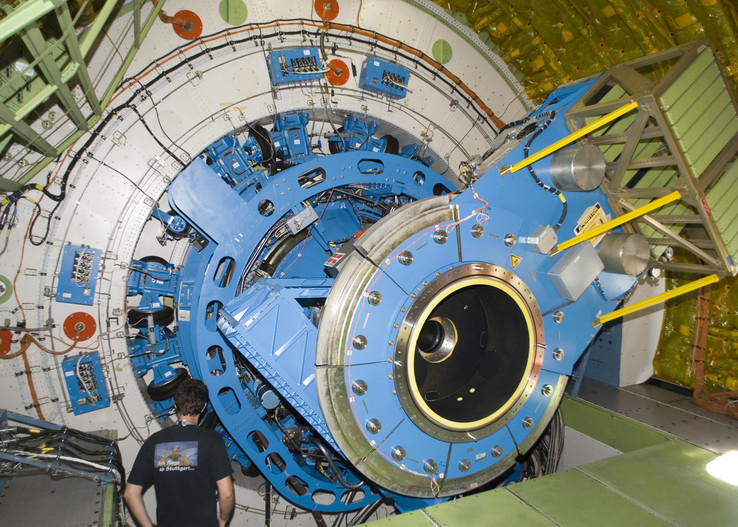
The DSI team is responsible for operating, developing and maintaining the unique telescope, which weighs around 17 tons.
© DSI
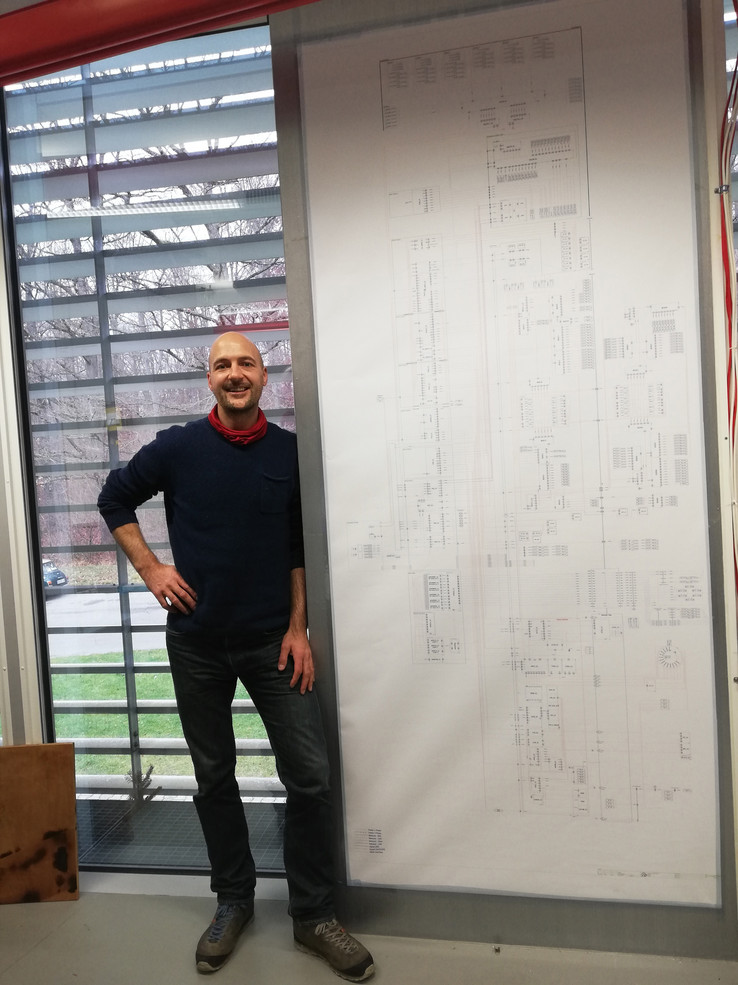
Simon Beckmann, next to the printed "Harness Master Diagram" (HMD), says: "Our highly specialist requirements mean we probably use 90% of all EPLAN functions".
© SOFIA
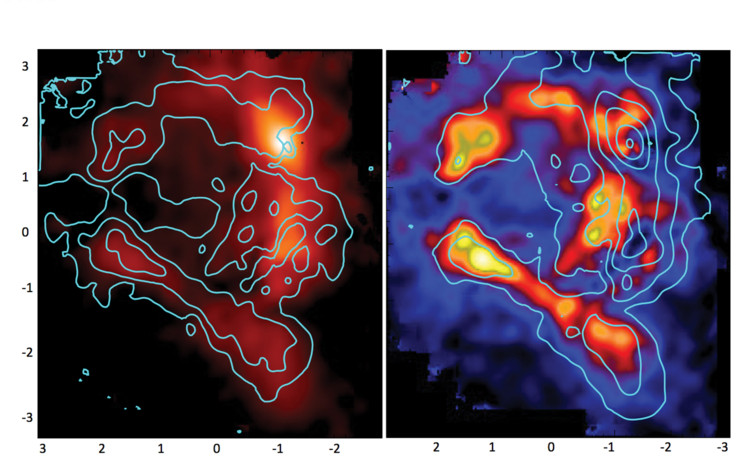
Infrared images – here of the constellation Orion – provide information about the development of star systems and the birth of new stars. The image on the left shows ambient dust temperatures. The image on the right shows the gas created by dust clouds from star formation.
© SOFIA


